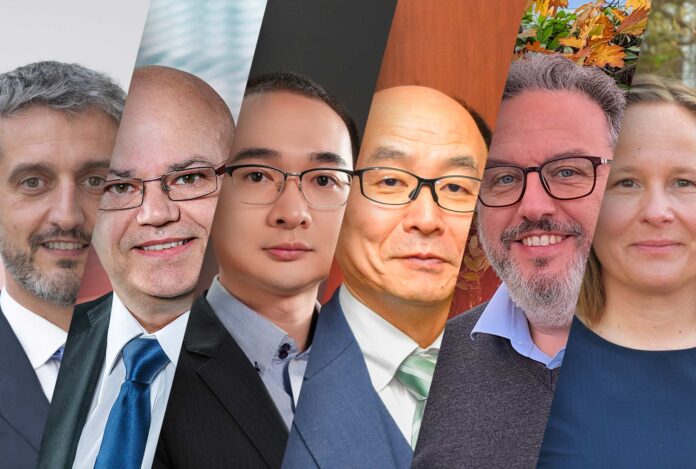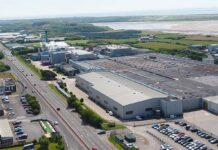
Leading companies outline their strategies for virtuous and cost controlled energy, hybrid technologies, the importance of quality AI, and the “profound impact” the EU’s Green Deal will have on the industry.
TWM/1: What technological advancements really stand out for your business from the past year, and what R&D are you looking into for 2024?
Luca Billi, Sales Manager, A.Celli Paper: “Over the past year, the A.Celli group has matured, developed and designed a series of technological innovations that have had a positive spin-off and been well-received by the industry. With regards to the tissue world in particular, our main effort has been concentrated on the development of the new SMARNIP T technology, a shoe press for tissue that improves efficiency and performance while preserving the integrity of the final product and maintaining its bulk and softness. Our new solution combines the reliability and robustness of the previous versions developed by PMT with the functionality and low maintenance requirements of pneumatic feeding. Of course, interesting developments are also in the pipeline for 2024, which we will continue to introduce to the market, with the main objective of satisfying our customers’ needs.”
Paul Richards, Senior Technology Manager Tissue, Andritz: “PrimeLineTIAC – our Tissue Innovation and Application Centre located in Graz, Austria – is an excellent tool for Andritz and its customers to develop methods for reducing their overall CO2 footprint by investigating various process inputs and outputs: furnish (alternative fibres), energy sources (gas, steam, electricity), and fresh water as well as effluent, chemicals, and emissions. What’s more, the PrimeLineTIAC is also a birthplace of Metris, Andritz’s digital solutions for the tissue industry. Several of the concepts have made it to the order phase and are being implemented to further reduce the industry impact on our environment.”
Benny Peng, Vice president, Baosuo Paper Machinery Manufacture Co.: “Improving equipment operation speed and stability is the main way to create higher production efficiency for customers. In 2023, our model with a design speed of 1,600m/min broke through the highest operating speed record and highest production efficiency index for the first time. Customers repeated orders for the same model in twice the quantity in the second phase. Additionally, Baotuo paper machine has achieved technological breakthroughs in the 1,800m/min model and has won the favour of some high-end customers at home and abroad, reaching purchase intentions.
“In 2024, our research and development work will focus on the upgrade and optimisation of existing models and the research and development of TAD paper machines. TAD paper machines have the advantages of saving raw materials, product multi-functionality and high-water absorbency, and are favoured by tissue manufacturers. Our newly developed TAD machine is expected to be put on the market in 2024. We provide TAD paper machine equipment and services to high-end paper product manufacturers.”
Shinji Goda, Director, General Manager of Design Department, Kawanoe Zoki: “We are working with our customers to develop products utilising pilot converting machines in our technical centre. This year, we have newly introduced a thermal calendar to manufacture prototypes and collect test data for paper, non-woven fabrics, other sheets, and composite materials. We will continue to develop new products together with our customers. We have also already succeeded in making continuous sheets made from cellulose nanofibres.
“This year, we have presented our results at various exhibitions and academic conferences related to cellulose nanofibers and have received a variety of positive feedback. The characteristics of the sheets produced from the supplied raw materials vary, and we expect to continue to contribute to the development of their applications in the household paper industry.”
Francesco Simoncini, R&D Technical Manager, Toscotec: “In the dynamic space of paper machinery, innovation stands as the driving force of progress. This industry is grappling with a unique challenge: balancing the pursuit of enhanced efficiency with the ever-evolving demands of customers. The delicate equilibrium between technological advancement in a traditional market and meeting customer requirements is central to the evolution of this space. First and foremost, Toscotec has increasingly been focusing on decarbonisation in recent years by ensuring that its technology can function with renewable energy. Many innovations focused on decarbonisation and reduction of the environmental footprint of tissue making lines are scheduled to be disclosed and introduced into the market soon. These go hand-in-hand with technologies designed to reduce and differentiate resources such as water and fibres. Secondly, lower energy requirements have also been achieved by introducing more efficient methods of dewatering like the capillary medium. Toscotec’s new INGENIA concept represents the summa of all the main innovations recently developed. INGENIA is a flexible production line of both structured and dry creped tissue, where energy efficiency, easy operation, and maintenance have come together in a coherent system.
“Thirdly, we continue improving existing products, with a special focus on Toscotec’s iconic product, the Steel Yankee Dryer. We upgraded TT SYD’s proved reliability by aligning all its manufacturing procedures with state-of-the-art technological advancements and introducing a special treatment for the internal surface for operation even in the most aggressive conditions. Moreover, interesting product development results have been achieved with the new OPTIMA line that completely renewed the rewinder section to preserve the tissue properties of the parent reel, maximising softness and product quality.”
Jenny Lahti-Samuelsson, Vice President, Tissue Mills Sales, Valmet: “The first priority is developments that contribute to optimising operational cost of customers’ machine base, including sustainable solutions. Not only development of disruptive solutions but also incremental improvements of current technologies and utilisation of new technologies already applied in other industries.
“For example, using hydrogen and electricity as power supply for hot air in the drying process, as well as optimising press, Yankee, and hood with respect to linear loads, Yankee diameters and hood solutions. Secondly, we see a need of product development to make tissue manufacturing “easier to operate,” whether it is with help of digital tools or simpler interfaces, less maintenance needs etc.
“Thirdly we face an increasing interest in upgrades and rebuild solutions to help customers optimise their existing machine fleet. It is not only the technology itself that is of importance; also, it is of essence how we are executing the projects together, as supplier and customer to have a smooth and successful project. As always, the constant cost pressure forces us in finding the more cost-efficient solutions also from a customer capital investment point of view.”
TWM/2: What requests have customers been making in terms of improved energy efficiencies in 2023, and how has your business responded?
Billi: “All technological solutions developed by A.Celli are conceived, right from the conception and design phase, with a focus on efficiency. This approach allows us to guarantee our customers low energy impact production. As evidence of this trend we can mention, in addition to the already mentioned Shoe press SMARNIP T technology, other recent innovations that we have launched on the market in recent years, such as the forged Yankee dryer, its iDEAL Evo-lock variant and the A.Celli X-Roll. To complete the offer with a view to integration but always with a focus on efficiency, the A.Celli group has recently promoted the R-WAY solutions dedicated to automatic product handling and plant intralogistics. In a more general and transversal perspective, talking about the subject of digitisation, we have developed a specific solution that is part of the OMNIA DP offer. One application, in particular, ‘Energy Management’, is capable of collecting production data from all the gateways on the machinery and analysing it to obtain a complete overview of the energy consumption of all the equipment in the plant. Moreover, the application provides indicators for monitoring and useful information for reducing emissions as well as for the precise identification of the cost per unit of product.”
Richards: “As one part of this commitment to sustainability, we have made significant progress in energy reduction in general. The reduction in energy use makes both economic and environmental sense – basically, it is a sustainable strategy in the full sense of the term. Regarding the latter, we have specifically made significant progress in reducing the use of fossil fuels by developing efficient green energy solutions. Our clear intention is to keep improving in both areas – reducing energy consumption in general as well reducing the use of fossil fuels. Ultimately, our customers need new developments in both of those areas to operate more efficiently, especially considering the challenges posed by the global energy supply and the instabilities we all face. Andritz will therefore remain highly committed to developing technologies that reduce energy costs while also enabling enhanced product quality.
“To provide one concrete example for PrimeLineTM, Andritz has optimised its shoe press design and concept. Our PrimePress XT Evo, with its patented loading design that ensures a constant pressure in CD, along with its edge control system and optional cantilevered design, has tangibly helped tissue manufacturers capitalise on energy and fibre savings without sacrificing their OEE (overall equipment effectiveness). In dryness mode, for example, the after-press dryness can increase by up to 6% compared to a suction press roll, resulting in thermal energy savings of up to 24%. In quality mode, paper bulk is improved, resulting in better paper quality and/or possible fibre savings of up to 10% compared to conventional presses. We have recently installed and started up a PrimePress XT Evo fully cantilevered shoe press on a new PrimeLineTM in North America, as well as a rebuild to the same, in the European region. As for PrimeLineTAD, Andritz continues to optimise its very successful steel Yankee dryer, thereby demonstrating its capability for TAD applications. At the same time, we continue to investigate advanced dewatering concepts to reduce energy usage, together with alternative fuel sources, to reduce the environmental impact in TAD.”
Goda: “We are continuously receiving requests for energy reduction proposals in response to the demand for CO2 emission reductions. However, there are many cases in which customers are wondering how to proceed in a specific order. For this reason, we have started “Equipment Diagnosis” of the current situation that will provide hints for energy saving. Firstly, we accurately grasp the current situation, and then in consultation with the customer we propose the most appropriate energy efficiency modification that meets the customer’s budget. We also conduct “Equipment Diagnosis” after the modification, share the results, and continuously discuss the next steps toward greater efficiency.”
Peng: “Customers have put forward higher requirements for reducing the energy consumption of water, electricity and steam used by paper machines. In response to customers’ needs for energy saving and consumption reduction in production, we have taken the following measures:
Optimise water treatment processes. We recommend customers use more efficient water treatment devices to improve the quality of production recycled water. Part of the clean water used on the paper machine can be replaced with ultra-clean recycled water, such as high-pressure cleaning water for screens and carpets.
For a long time, high-power consumption processes have used the IE5.0 high-efficiency intelligent control motor with higher energy saving effect. Depending on the occasion used, the energy saving effect is 25%-35% higher than that of conventional variable frequency motors. Reducing energy costs can bring more substantial returns to customers.
Optimise steam condensate system. Only the Yankee cylinder uses fresh steam, and all steam hoods use secondary steam heating, which maximises the recovery of heat energy in the steam to reduce unnecessary waste.”
Simoncini: “The tissue industry advances several key requests and priorities when it comes to energy efficiency. Improving energy efficiency is important not only to reduce operational costs but also for environmental sustainability. The latter is becoming more and more important, considering new environmental legislations that are currently being passed globally. This trend is certainly not going to change in the short and medium period. In this climate of global instability, paper producers are more careful in evaluating big investments directed at installing new, state-of-the-art, highly efficient tissue making plants. At the same time, there’s an increasing number of major rebuilds or even smaller projects with a focus on productivity and energy efficiency of existing plants. In any case, with well-conceived implementations, it is possible to substantially increase the efficiency of old plants with limited investments. Customers usually ask for energy surveys to find out the best efficiency intervention for their specific case. A significant efficiency increase is obtained by replacing the most energy-intensive components, for instance in the dryer section and air system. Here the integration of dewatering and drying processes obtained with recovery systems enables the production of steam and hot air even from low temperature exhaust gases.”
Lahti-Samuelsson: “There is a growing interest in Valmet’s hybrid technologies based on the global trend towards higher tissue quality. Looking closer at the hybrid technologies, the results from the latest installations are clear; tissue quality close to ultra-premium can be achieved with a comparably significantly lower energy and fibre consumption. But even smaller investments in rebuilds or upgrades in the pressing and drying area can have a significant impact on the energy and production efficiency. The Advantage ViscoNip press has become a benchmark in reducing energy consumption and at the same time improving runnability and tissue quality”
TWM/3: How is AI changing your business, and what opportunities and challenges are there for the tissue industry generally in adapting and advancing with AI?
Billi: “Systems and applications that base their functionality on the use of AI are now increasingly present in the industrial fabric industry, not only in the paper industry, but across all sectors. This transition is profoundly affecting the way companies operate and compete. It is now obvious that those who manage to exploit these technologies could gain a significant competitive advantage over their competitors. A.Celli guarantees a very high level of attention to the evolution of these disciplines and of the entire IT and digital sector. Our commitment goes back a long way to when, in 2016, a division dedicated to digital solutions, Extreme Automation, was founded. Today, our offering – OMNIA DP – consists of a flexible, cloud-based software suite capable of monitoring and improving almost every aspect of a production plant, from anywhere, at any time. The integration of all this, with the generative potential offered by artificial intelligence systems, is already being implemented.”
Richards: “Autonomous operation of industrial plants refers to the plant or facility’s ability to operate and manage its processes with minimal human intervention. This means that the plant can function independently, without the need for constant human oversight. The concept involves integrating advanced technologies such as AI, machine learning, robotics, and the Internet of Things (IoT) to enable self-monitoring, self-diagnosis, decision-making, and control. The goal of autonomous operation in industrial plants is to enhance productivity, reduce operational costs, improve safety, and optimise resource utilisation. By leveraging advanced technologies and intelligent systems, these plants can achieve higher levels of efficiency, reliability, and responsiveness in their operations. In an autonomous industrial plant, multiple systems and components collaborate to enhance performance, productivity, and efficiency, while also ensuring safety and compliance. With a single integrated solution, Metris Andritz-Digital Solutions combines several essential elements to achieve autonomous operation in industrial plants.”
Peng: “AI has achieved great success in the application of turnkey solution for tissue intelligent equipment provided by Baosuo Enterprise Group. The production line provided to Asia Symbol’s Guangdong base requires no manual intervention from the paper machine, converting, packaging, and warehousing. According to this standard, the second phase of construction was determined. At the same time, we optimise equipment performance, operating experience, production efficiency and other indicators, hoping to bring better experience and higher benefits to customers.”
Goda: “Currently, our design department is using AI to implement a design system kaizen (a Japanese term meaning change for the better or continuous improvement) called “Design Kaizen”. This is to consolidate design know-how from the past to the present and realise “knowledge sharing” using AI. We expect that this will dramatically increase the speed of development by sharing innovative ideas with others and at the same time, reducing the burden on designers. In the near future, we believe that AI will be very effective in improving productivity by accumulating a variety of data on the equipment we provide, such as monitoring equipment and optimising operating conditions using AI.”
Simoncini: “AI is a technology that involves the use of computer systems and algorithms to enable machines, processes, and systems to perform tasks that typically require human intelligence. AI in the industry aims to enhance efficiency, productivity, and decision-making by simulating human-like cognitive functions, such as problem-solving, learning and perception. In this field, since we’ve become part of Voith, we have benefitted from the great experience developed by BTG or Voith itself. Our approach to AI-supported automation is to progressively integrate advanced AI systems in our machines based on levels of advancement increasingly more complex and complete. A first level, called Data Park, includes a supervision system of data storage and analysis aimed at finding non-trivial correlations between several and different process and system measurements. This proved to give a strong support to machine operators, mainly during the commissioning and start-up phases, but also in transient conditions during production changes. A second level includes the generation of Virtual Sensors able to estimate in real-time the value of non-directly measurable quantities (like softness, tensile strength, etc.) based on process data. The knowledge of these values will be of great help to paper mills to correctly schedule the production and to easily manage the transient periods between products changes, increasing the overall plant efficiency. The last level and the final target we are aiming for is the completely automated plant, in which the operator enters the final product specifications and the system, and the AI component is able to set all the parameters to obtain exactly the desired product.”
Lahti-Samuelsson: “Digitalisation of products is evolving day-by-day taking us towards more autonomous mills. The pace will be set by the actual needs from the industry and of course the payoff of the solutions. The tissue industry is today often challenged by difficulties to find and keep the right competence, and this is itself making the need of AI even more important. We as suppliers have a big role in this development. AI by itself cannot create wonders. It is the amount, quality, and management of data which feeds AI tools that is of importance. The challenge is to keep it at a reasonable cost, which as said will set the pace for advancement of AI applications and solutions.”
TWM/4: What environmental and/or social advancements has your company made in 2023, and what is in store in 2024 for the company’s sustainable development?
Billi: “The entire A.Celli group has made environmental sustainability goals a cornerstone of its vision by embarking on a virtuous energy path many years ago that sees us efficient and autonomous. All this has allowed us to be a reality that has practically reached the goal of zero impact, thanks to the implementations linked to sustainability and the adoption of best practices, and to the fact that we are, by nature of production, a non-energy consuming and non-polluting company. Also and above all for the future, the A.Celli Group confirms its commitment to pursuing the social responsibility of doing business, through facts, actions and concrete responses, supporting solid and sustainable growth over time.”
Richards: “Andritz Group is committed to a sustainable future. We aim to achieve significant environmental goals by 2025. We plan to generate 50% of our revenue from sustainable products, reducing our greenhouse gas emissions and waste volume by 50%, and cutting water consumption by 10%. Together, we’re building a greener, cleaner tomorrow.”
Peng: “Focusing on the overall strategic planning goals of Baosuo Enterprise Group, Baotuo Paper Machine continues to increase deeper exploration in energy conservation and consumption reduction. Especially in terms of steam and electricity consumption per ton of paper, which account for a considerable proportion of production costs, we aim to reduce the investment by 5-10% in an investment plan acceptable to customers and promote multiple energy-saving solutions for customers to choose from. At the same time, we pay attention to consumers’ demand for tissue and the needs of different tissue manufacturers for production equipment. Comprehensively consider the relationship between ecological protection, social needs and investment funds, we provide a turnkey solution for tissue production that conforms to the concept of sustainable development.”
Goda: “In order to improve the working environment for workers involved in logistics in Japan, strict overtime regulations will be applied starting in 2024. This is known as the “2024 problem in logistics,” and is expected to result in a shortage of drivers and a 14-34% reduction in transportation capacity, a serious problem.
“To avoid these problems, the paper industry has seen an increase in new products that reflect improved transportation efficiency, such as longer toilet rolls, soft-pack tissue cases, and shared transportation pallets, which have already received high valuation and increased sales volumes.
“Through the development of new products arising from these market backgrounds and the resolution of problems faced by customers, we will engage more deeply with customers and meet their needs.”
Simoncini: “The Green Deal, the EU’s ambitious sustainability agenda, is set to have a profound impact on the paper industry in the years to come. With a primary goal of achieving carbon neutrality and fostering a circular economy, this initiative will drive significant changes in paper manufacturing. Toscotec’s approach to this huge challenge is not only to introduce technology designed to substantially increase the energy efficiency of the plant, but also to develop components and systems that could give the maximum environmental impact reduction in combination with the decarbonisation of the energy sources.
“Energy efficiency is something we have been working on for several years, pushed not only by environmental reasons, but also by the market request to reduce operating costs. This explains the reason why today, the most efficient and modern plants are concentrated in the areas of the world subject to the energy price crises. Toscotec’s technology is becoming compatible with low carbon energy vectors to benefit from the increased use of these sources. For instance, electric energy generated from renewable sources is becoming more and more common. Toscotec’s R&D has been focusing on replacing all the energy-intensive components of the paper mill with systems directly powered by electric energy. For example, heating of the Yankee dryer through induction, heating up the air in the hood system with electrical batteries, and using heat pumps to generate steam. Where the use of electric energy is not fully consolidated in terms of installation or capacity, like in the air systems where relatively high temperatures are required, the possibility to replace natural gas with the use of hydrogen or bio-mass gas is under advanced testing phase.
“Another important field Toscotec is taking into great consideration is water consumption reduction. A lower water consumption is necessary to make paper manufacturing more environmentally friendly to preserve on one side such an important resource and on the other side reduce dewatering and drying needs. This target has been addressed with the introduction of several innovations both for new and existing mills like a tailor-made and integrated approach to the process and the introduction of recovery systems able to work with low temperature exhaust gases. In this way, even the moisture contained in the air system exhausts can be condensed and recovered while the heat is used to generate hot air and low-pressure steam for the plant and the process.
“New disruptive technologies under development aim to drastically reduce water usage in the entire tissue making process. The biggest challenge for these technologies is finding a completely new way to distribute the fibres using less or no water and less chemicals, while retaining the paper properties typical for tissue products at the end of the process (strength, bulk, softness, absorbency, stretch). Fibre recovery from alternative sources (non-wood fibres) is also a challenging topic we have been working on in co-operation with several experts in the field: we have been looking at alternative fibres produced from agriculture residues or industrial waste. Many of the above concepts have been already presented to the market and are ready for implementation, like the integrated approach to the use of water and hydrogen, biogas or electrical heaters in the air systems. Other innovations are in the making and will be presented soon.”
Lahti-Samuelsson: “During 2023, Valmet started up three additional hybrid machines which is clear evidence that there is a demand in the industry for higher tissue quality produced in a more sustainable way i.e. with less energy and fibre consumption. The hybrid technology allows customers to work on end-product design taking benefit of the fact that the same calliper can be achieved with 20-25% less fibre, compared to conventional dry creped tissue. With the hydrogen technology utilised as fuel for hood burners and installation of electrical heaters it is now possible to produce tissue with zero CO2 emissions (when electricity is produced from carbon free process).”
TWM/5: What changes have you seen in tissue demand/supply and tissue trends in America and in China over the past year?
Billi: “The focus on sustainability is an increasingly evident factor. This is noticeable in the North American market, but also globally.
“Particularly in the more developed markets, the trend is clear: consumers are becoming more aware of the importance of recirculation and reuse, and manufacturers are increasingly encouraged to position themselves in the market with ‘green’ products. This growing interest has generated a demand for environmentally-friendly tissue products, more sustainable production processes and reduced environmental impact.
“The tissue industry is working hard to promote sustainability and circularity throughout the supply chain, starting with a focus on the water and energy used in production processes, thinking about the effects of transporting tissue products, and concluding with their recovery and recycling at the end of their life cycle.
“With reference to China, we have noticed a change in direction, reducing investments aimed exclusively at increasing the quantity of production, and beginning to focus also in the direction of a demand for high quality tissue products, with local manufacturers thus raising the level of production technology and quality of the final product.
“Ultimately, we look forward to a 2024 full of significant opportunities and challenges for the entire tissue industry.”
Richards: “The North American market is, in every sense of the word, a mature market. Consumers have definite expectations, and even in times of stress on the markets, are not prepared to compromise those demands in terms of quality and functionality. For this reason, despite the high energy demands TAD is still the driving force in the tissue market. “What is happening though is that our customers are looking at every aspect of their operation to determine how they can meet the environmental expectations of the consumer today. New project enquiries are looking to drive towards net zero carbon or close to it, and as suppliers we are having to use all our development and research efforts to address those needs.
“On the other side of the coin, China is, despite the market size, still a developing market. In many ways the supply side is very fractured, mostly due to the size of the area and the lack of infrastructure away from the industrial East/South East regions. The consumers are starting to force themselves to be heard, and producers are having to respond with product offerings that are moving up the quality ladder into hybrid and TAD areas. Infrastructure is the biggest issue, and in many areas there are insufficient supplies of primary energy to support traditional operations, which is forcing us as suppliers to develop alternative systems that can operate at the lowest possible energy levels, thereby creating an additional focus on overall energy reduction R&D needs. This certainly looks set to continue, and even accelerate, over the coming years.”
Peng: “In the past year, as a necessary consumer product for people’s lives, the demand and supply of tissue have continued to grow steadily in China and the United States. At the same time, consumer demand for household paper has exceeded its basic functional requirements and has put forward multi-functional, differentiated, and segmented needs, such as: ultra-soft tissue products, apply cream tissue products, and infant care tissue products, etc.
“In the foreseeable future, the United States will still be the main consumer area of household paper. China has a large population base and great consumption potential, and will become one of the major production and consumption areas of household paper in the world.”
Goda: “In China, some financially-strong manufacturers are trying to avoid cost competition and focus on producing more profitable, high value-added products to differentiate themselves from their competitors’ products. While premium bulky products are being supplied to the market, tissue products are becoming lower basis weight, and demand for wet toilet paper is increasing, resulting in a diversification of product applications. Thus, we expect the Chinese household paper market to continue to grow steadily, although it will change from the rapid growth it has been experiencing to stable growth.”
Simoncini: “In general terms, global tissue consumption accelerated in 2022, but at a lower rate (2.6%) than the average growth rate of the past 20 years. Focusing on the two global tissue leaders, China and North America, we observed that China is keeping up the very high growth rates of consumption it had in recent years, and it is de facto driving global tissue demand. At the same time, there’s the long-standing issue of overcapacity and the low operation rating of tissue machines.
“In North America, the tissue market stagnated like in Western Europe, showing low growth levels. The market as a whole is faced with the need to upgrade its technology and increase its efficiency. This represents an attractive opportunity for Toscotec because we also specialise in highly customised rebuilds for energy efficiency, of which we are leaders in Europe.
“Going forward until the beginning of the next decade, China is expected to be the fastest growing market followed by North and Middle East, Africa, and Latin America. These are all markets where Toscotec is establishing an increasingly stronger presence. In China, we target the market share reserved to new products of texturised and structured tissue. In America, we expect an increasing environmental awareness to drive a growing interest for technological solutions designed for energy savings.”
Lahti-Samuelsson: “Both China and America are currently focusing on cost efficiency, i.e., optimising operational cost and energy consumption. In America, there is an increasing interest in revitalising the existing machine fleet with smart solutions. The drive to meet changes between segments, private label vs branded products are also impacting tissue manufacturers in America. In China the awakening demand for higher tissue qualities seems to remain in 2024 and beyond. The hybrid technologies are good tools to produce premium quality tissue in a more sustainable way.
“Legislations and thus cost development for energy, fibre, and emissions will also set the path for the development trend.
“The world is of course in a precarious situation where the geopolitical situation is extremely hard to predict and thus also how the industry will change and in what pace. One thing that is sure is that we need to think flexibility, efficiency, sustainability, and user-friendliness in the solutions we deliver to adapt to the volatile market.”

































